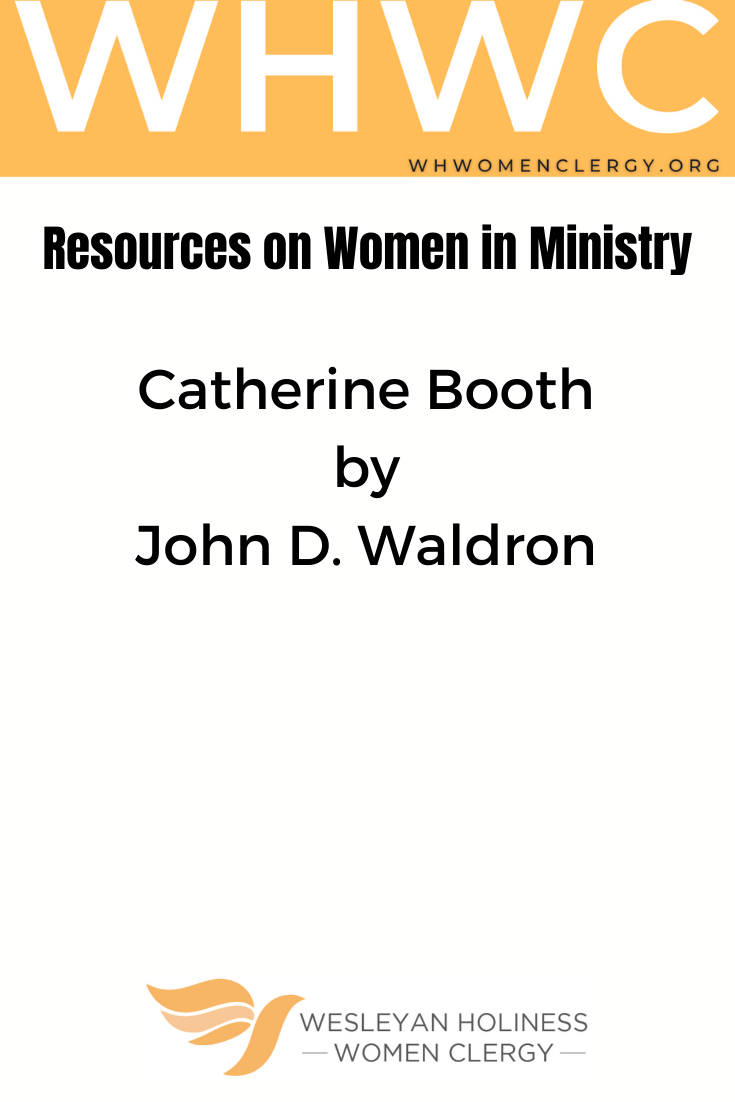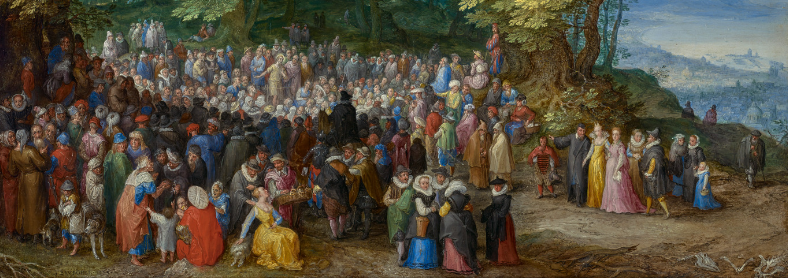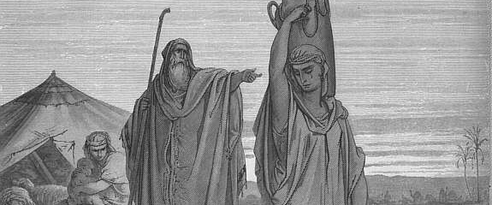Commissioner John D. Waldron retired in 1982 as Territorial Commander for The Salvation Army in Canada and Bermuda Territory. He is The Salvation Army's foremost anthologist with twelve published works.
Catherine Booth
John D. Waldron • March 9, 2022 | WHWC
Influencer of a Holiness Movement that Continues

To her contemporaries, Catherine Mumford Booth, co-founder of The Salvation Army, was the epitome of eloquence, compassion, clarity of thought, Scriptural knowledge, forthrightness, and decisiveness.
She was preaching in London's City Temple in 1888. In her audience was a young American seminarian named S. Parkes Cadman. Several decades later, himself a preacher of world renown, he reflected on that experience. "I have not heard since," he declared, "anything which moved me more deeply than that remarkable address . . . delivered in the purest English, with faultless diction, in a voice like the pealing of a silver bell across a still lake."
Frederick Booth-Tucker, her son-in-law/biographer, quotes a contemporary religious periodical, "Mrs. Booth was a woman of no ordinary mind, and her powers of argument are of a superior character. Her delivery is calm, precise, and clear . . . her language is simple but well-chosen, and her ability for speaking is beyond the general order. Our ministers would do well to hear Mrs. Booth."
Who was this remarkable woman? Her voice will have been stilled for one hundred years in October 1990. However, she is still recognized throughout the world as the Mother of an Army, a preacher of superb power, and a partner in the creation of an international movement dedicated to the proclamation of Scriptural holiness as well as to the alleviation of the world's human miseries. Catherine Mumord's early childhood was unpretentious. Her home was comfortably middle-class, her father a prosperous carriage-builder and fervent lay preacher, her mother a devout Christian and loving wife and mother.
Quite early in life, however, Catherine was plagued with debilitating health problems, often necessitating long periods in bed. With a frail body, and little formal schooling, she developed a voracious appetite for reading. Besides her Bible, this included scholarly theological writings far beyond her years.
During her teens, her father resigned his ministry, and became a leader in a temperance group—then began to drink the liquor he had renounced. His frequent drunkenness became a matter of acute embarrassment and pain to his sensitive daughter. Her mother died after a struggle with cancer. Her only brother went off to San Francisco, a confirmed skeptic, and until Catherine's death she prayed for his salvation. Her own health remained fragile, and she was seldom without pain.
Then, in her early twenties, she met a dynamic young preacher named William Booth. United in heart and soul, their subsequent courtship and marriage reads like a storybook romance. Their letters throughout their lives reveal a rare combination of human intimacy and heavenly union. From this point on, the life of neither can be assessed separately.
As we approach her 161st birthday on January 17, 1990, her lasting influence is apparent not only on The Salvation Army, but upon the whole Christian church, especially those who proclaim the doctrine of holiness.
As a mother of eight children, parents find in her an example of tenderness, discipline, common sense, and Christian instruction. All of her natural children followed her into various Christian ministries, largely under the Army flag. However, at home, she was always the practical mother, tending to the everyday needs of her family.
Her daughter Emma, writing after her mother's death, asked the question, "Did her public duties conflict with her care for us, her love, her solicitude for our welfare? Was she less a mother because she was so much a warrior?" To which she gives an emphatic response, "Oh, no! Never was mother more of a mother than mine, in the truest sense of the word. To see her in the nursery one would never imagine the powerful preacher."
To Salvationists, she is the Mother of our movement. When her husband was confined by a prolonged illness in the early days, she was in charge of the Mission for many months. A warrior herself, she nevertheless brought a sensitive, gentle touch to the Army's battles against all kinds of evil, encouraging many aspects of our warfare, which are part of the Army's heritage today. She helped to design the Army's flag, and presented the first one to the Coventry Corps. She encouraged the wearing of uniforms as a distinctive Christian witness. She designed the first Army bonnet—not for style so much as to protect the heads of the first Lassies from the refuse thrown at them during bitter days of persecution.
Her renown as a preacher came after a struggle with her own timidity in public. Feeling divinely led at the conclusion of one of her husband's early services, she strode to the pulpit, declaring, "I want to say a word." From that time on, her powers increased, and she was in constant demand, especially among the West Enders of London, congregated in music halls and drawing rooms.
Emma remembers that her mother "had often to stand, single-handed and unaided, to face the large and refined audiences which were drawn together by the mere announcement of her name. Her vehement denunciations of wrongdoing, her bold advocacy of the right, her championship of the oppressed, her zeal for the cause, her beautiful self-forgetfulness, her transparent simplicity, her invincible courage . . ." were all elements of her preaching.
She soon became the champion of the principle that women, as well as men, were called to preach. A clergyman had written a strong objection to the preaching of Phoebe Palmer, an American evangelist. Catherine responded with a carefully reasoned, fervent rebuttal entitled "Female Ministry." More than a century later, the pamphlet is still in print, and the principle is still being debated by the Church. A multitude of women Salvationists, as well as many in other Churches, now follow her example in the preaching of the Word.
She was a partner with her husband in their compassion for the poor, translating creed into deed, and giving new meaning to John Wesley's dictum that "there is no holiness except social holiness." Booth's great epic, "In Darkest England and the Way Out," was written during her last illness, and each page was brought to her for her review at the close of each day's writing.
Her teaching of holiness was clear, doctrinally sound, tested by experience, and scripturally based. Her strong emphasis on Entire Sanctification not only influenced the continuing emphasis of the Salvation Army, but also antagonized some of the Movement's early supporters who were less committed to the doctrine. To a distinguished churchman who criticized her teaching, she wrote a carefully reasoned and documented response. She challenged him to "consider that our views are substantially one with those of Upham, Wesley, Fletcher, Finney, the teaching of many Friends, and of the Holiness people of America."
How interesting that two of the four named were Americans! How ironic that she included the Presbyterian/Congregationalist along with the founder of Methodism! It is clear that her teaching arose not only from Scripture and experience, but also from a careful study of holiness writings from both sides of the Atlantic.
Catherine Mumford Booth had never known robust health. Before she had reached her 60th birthday, the doctors had diagnosed cancer. In the late 1880s, very little could be done to relieve her two years of agony. To her family, she cried out, "The waters are rising, but so am I."
In death, the warrior-saint was a victor, as in life. The City of London stood still as her cortege passed by. Her husband gave an eloquent, moving tribute. Ten thousand mourners repeated a grave-side covenant, "We solemnly promise . . . true to our cause . . . devote ourselves to saving souls . . . faithful to Thee." Nearly a century later, her example and teaching encourage us to make the same commitment for the 1990s.

Enjoyed this article? Connect with us on one of our social media platforms. Share it and forward it to a friend:





